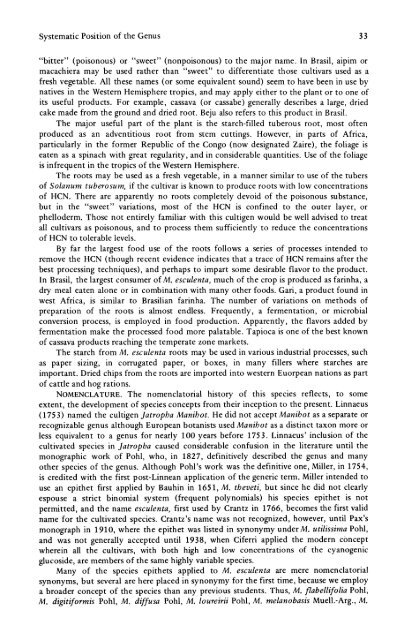Manihot Manihotoides (Euphorbiaceae) - CNCFlora
Manihot Manihotoides (Euphorbiaceae) - CNCFlora
Manihot Manihotoides (Euphorbiaceae) - CNCFlora
You also want an ePaper? Increase the reach of your titles
YUMPU automatically turns print PDFs into web optimized ePapers that Google loves.
Systematic Position of the Genus 33<br />
"bitter" (poisonous) or "sweet" (nonpoisonous) to the major name. In Brasil, aipim or<br />
macachiera may be used rather than "sweet" to differentiate those cultivars used as a<br />
fresh vegetable. All these names (or some equivalent sound) seem to have been in use by<br />
natives in the Western Hemisphere tropics, and may apply either to the plant or to one of<br />
its useful products. For example, cassava (or cassabe) generally describes a large, dried<br />
cake made from the ground and dried root. Beju also refers to this product in Brasil.<br />
The major useful part of the plant is the starch-filled tuberous root, most often<br />
produced as an adventitious root from stem cuttings. However, in parts of Africa,<br />
particularly in the former Republic of the Congo (now designated Zaire), the foliage is<br />
eaten as a spinach with great regularity, and in considerable quantities. Use of the foliage<br />
is infrequent in the tropics of the Western Hemisphere.<br />
The roots may be used as a fresh vegetable, in a manner similar to use of the tubers<br />
of Solanum tuberosum, if the cultivar is known to produce roots with low concentrations<br />
of HCN. There are apparently no roots completely devoid of the poisonous substance,<br />
but in the "sweet" variations, most of the HCN is confined to the outer layer, or<br />
phelloderm. Those not entirely familiar with this cultigen would be well advised to treat<br />
all cultivars as poisonous, and to process them sufficiently to reduce the concentrations<br />
of HCN to tolerable levels.<br />
By far the largest food use of the roots follows a series of processes intended to<br />
remove the HCN (though recent evidence indicates that a trace of HCN remains after the<br />
best processing techniques), and perhaps to impart some desirable flavor to the product.<br />
In Brasil, the largest consumer of M. esculenta, much of the crop is produced as farinha, a<br />
dry meal eaten alone or in combination with many other foods. Gari, a product found in<br />
west Africa, is similar to Brasilian farinha. The number of variations on methods of<br />
preparation of the roots is almost endless. Frequently, a fermentation, or microbial<br />
conversion process, is employed in food production. Apparently, the flavors added by<br />
fermentation make the processed food more palatable. Tapioca is one of the best known<br />
of cassava products reaching the temperate zone markets.<br />
The starch from M. esculenta roots may be used in various industrial processes, such<br />
as paper sizing, in corrugated paper, or boxes, in many fillers where starches are<br />
important. Dried chips from the roots are imported into western Euorpean nations as part<br />
of cattle and hog rations.<br />
NOMENCLATURE. The nomenclatorial history of this species reflects, to some<br />
extent, the development of species concepts from their inception to the present. Linnaeus<br />
(1753) named the cultigen Jatropha <strong>Manihot</strong>. He did not accept <strong>Manihot</strong> as a separate or<br />
recognizable genus although European botanists used <strong>Manihot</strong> as a distinct taxon more or<br />
less equivalent to a genus for nearly 100 years before 1753. Linnaeus' inclusion of the<br />
cultivated species in Jatropha caused considerable confusion in the literature until the<br />
monographic work of Pohl, who, in 1827, definitively described the genus and many<br />
other species of the genus. Although Pohl's work was the definitive one, Miller, in 1754,<br />
is credited with the first post-Linnean application of the generic term. Miller intended to<br />
use an epithet first applied by Bauhin in 1651, M. theveti, but since he did not clearly<br />
espouse a strict binomial system (frequent polynomials) his species epithet is not<br />
permitted, and the name esculenta, first used by Crantz in 1766, becomes the first valid<br />
name for the cultivated species. Crantz's name was not recognized, however, until Pax's<br />
monograph in 1910, where the epithet was listed in synonymy underM. utilissima Pohl,<br />
and was not generally accepted until 1938, when Ciferri applied the modern concept<br />
wherein all the cultivars, with both high and low concentrations of the cyanogenic<br />
glucoside, are members of the same highly variable species.<br />
Many of the species epithets applied to M. esculenta are mere nomenclatorial<br />
synonyms, but several are here placed in synonymy for the first time, because we employ<br />
a broader concept of the species than any previous students. Thus, M. flabellifolia Pohl,<br />
M. digitiformis Pohl, M. diffusa Pohl, M. loureirii Pohl, M. melanobasis Muell.-Arg., M.

















